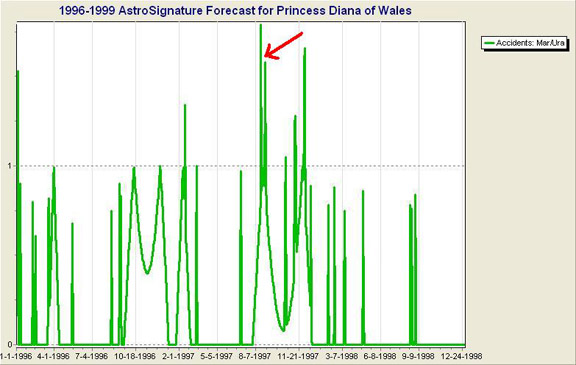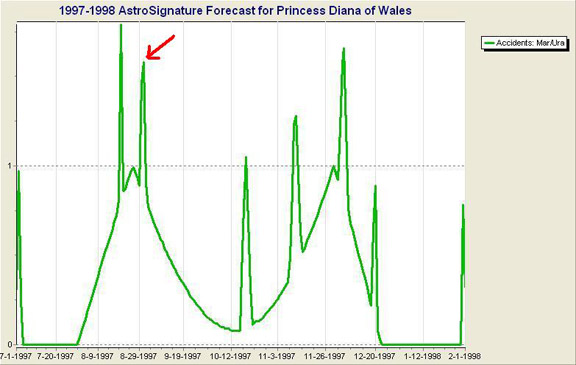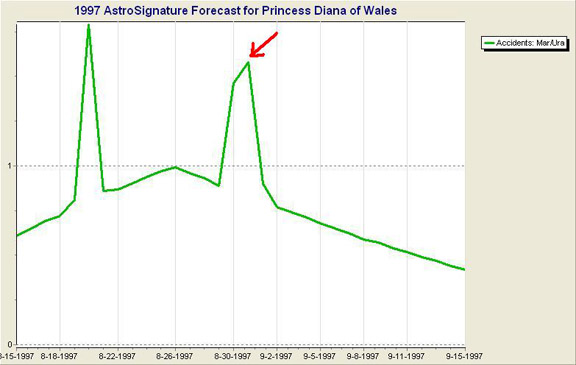
|
Accident Research with Midpoints
Copyright © 2008 All Rights Reserved A good subject for research is any extreme situation or trait. An example of an extreme situation is an accident. In an entire lifetime, one is likely to experience just a few major accidents. From an astrological perspective, one may wonder what astrological influences are in effect at these extreme and unusual moments in a person's life. Astrologers are likely to associate the planet Uranus and perhaps the planets Mars and Saturn with accidents. I believe that patterns involving 3 or more planets are extremely important and that midpoint structures are important, so I created the following AstroSignature: All direct midpoint structures involving Mars and Uranus with either the Sun or Saturn formed between the transiting and natal planets. A direct midpoint structure occurs when one planet is conjunct or opposition the midpoint of two other planets. The possible midpoint structures are: Sun conjunct or opposition Mars/Uranus midpoint Note that the AstroSignature can be either transit-to-natal or natal-to-transit. The first item, for example, may be either transiting Sun conjunct or opposition Mars/Uranus midpoint or vice versa: transiting Mars/Uranus midpoint to natal Sun. Therefore there are a total of 24 specific possible astrological influences because each of the 6 items listed above can involve a conjunction or opposition aspect, and may be either a transiting planet to natal midpoint or transiting midpoint to natal planet.
Using the Kepler 7 software, I entered this AstroSignature into the program. I then decided to look at the car accident on August 31, 1997 in which Princess Diana died. I looked at a graph for 3 years from the previous year to the following year, i.e. 1996, 1997, and 1998. The graph is shown below:  Although I produced this graph with the expectation that the graph might indicate August 31, 1997 as important, I was surprised to see the extraordinarily precise indication of the date. I added a red arrow to the graph to show the late August of 1997 time period. The graph is nearest its highest point in this time period. I then produced the graph for about a half year around the time in which the accident occurs. Shown below is this graph, which is for the time period July 1, 2007 to February 1, 2008:  Again, I added a red arrow to point to the date of the accident. We can see that August 31, 1997 is one of the highest peaks, and from the previous graph, we see that this peak is also one of the highest peaks over a 3-year time period. Below is the graph from mid August to mid September showing that the peak pointed to in the above graph is precisely August 31.  I then decided to look at one other famous catastrophic well-known event: the assassination of John Lennon on December 8, 1980. Shown below is the graph for John Lennon for 1980:  Again, I have added a red arrow to the graph to show the date of the assassination. Although not quite as dramatic as the graph for Princess Diana, again one of the highest peaks during the time period points precisely to the date of the tragic day. The software also shows the astrological influences in effect on these tragic days. The information displayed in the software is shown below: Aug 31, 1997 Tran-to-Natal For John Lennon the results are: Dec 8, 1980 Tran-to-Natal In other words, on the date of Princess Diana's fatal car accident, the influences were transiting Mars conjunct natal Saturn/Uranus midpoint with an orb of 15' and transiting Uranus opposition Sun/Mars midpoint with an orb of 10'. For the date of John Lennon's assassination transiting Mars/Saturn midpoint is opposition natal Uranus with an 8' orb. These orbs are approximate because they are not calculated for the precise time of the accident. With the Sirius software we can also view influences across a single day and of course the calculations can also simply be done for the exact time of the events. However, this is not necessary at this stage of the research because the exact orbs will not change greatly and the basic hypothesis is supported. We could now look at dates of other famous accidents and assassinations as well as dates of major accidents of anyone who has a recorded time of birth and the date of a major accident. There are many questions and issues that arise, as there is with any research. In this research, we could investigate different kinds of accidents, test other astrological influences, etc. This research study opens up a possibly very fruitful avenue for further research. Although this research provides very promising results, I have not yet continued this research further. I am engaged in many avenues of study and research in astrology, and have not yet been able to continue following this possibility. I am presenting this research study because it may be helpful to other researchers. The use of quantitative methods and visual tools for seeing results on a study of extreme events is a methodology that appears to be appropriate for research into astrological forecasting. Also, I wish to add that these two cases of Princess Diana and John Lennon are, thus far, the only cases that I have studied. Researchers have a responsibility to accurately and thoroughly present their methodology. Although this is a short article, it does present all relevant information for appreciating the nature of the study. This research was conducted in 1996 and was inspired by the need to develop a research topic for a lecture. The lecture was presented at the 2006 Balkan Astrology Conference in Belgrade, Serbia and received a very enthusiastic response. In the future a more concentrated and sustained effort to pursue this line of research could possibly produce replicable statistically significant results. With a study of only two cases, it is far too early to be very optimistic in this regards, but the methodology and variables studied do show some promise. In short, the final conclusion of this study is that the need for further research is very strongly indicated.
|
 David Cochrane is main author of the Kepler and Pegasus program. He is the lead programmer and professional astrologer at Cosmic Patterns Software. Daivd is also the author of the Major Life Themes Report, Harmonic Highlights Report, and AstroLocality Report.
David Cochrane is main author of the Kepler and Pegasus program. He is the lead programmer and professional astrologer at Cosmic Patterns Software. Daivd is also the author of the Major Life Themes Report, Harmonic Highlights Report, and AstroLocality Report. AUTHOR:
AUTHOR: 